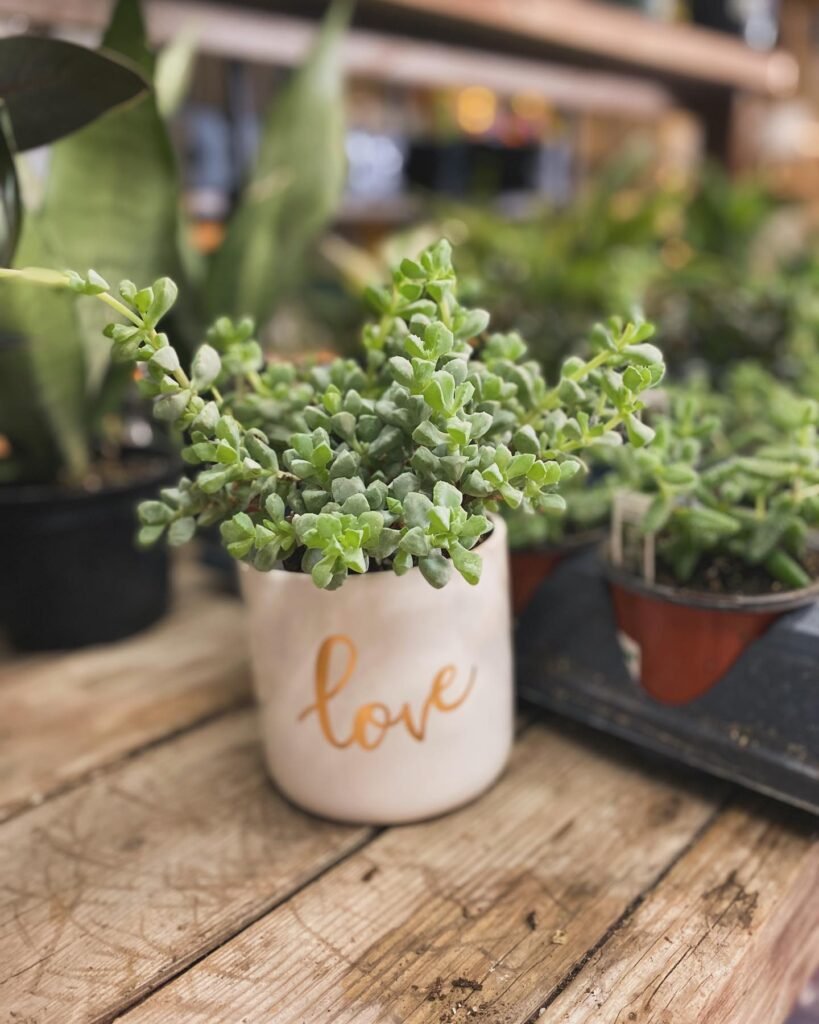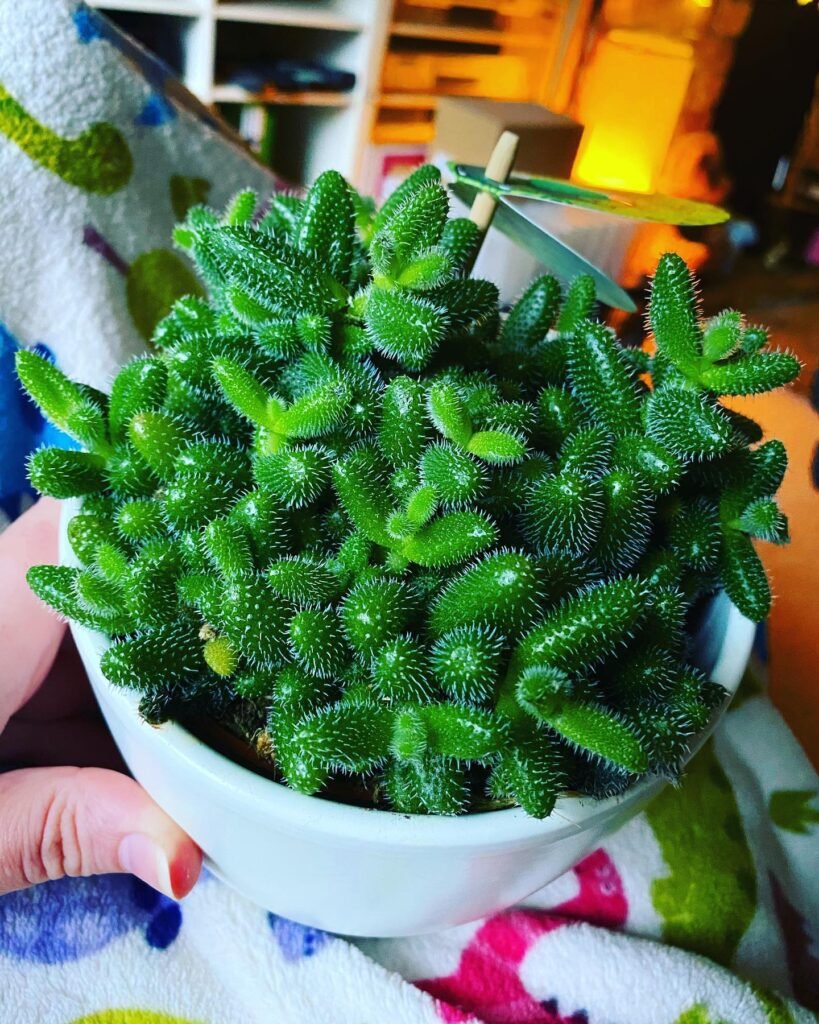Did you know that the Delosperma Echinatum, commonly known as the Pickle Plant, is a succulent native to South Africa that has gained popularity among gardening enthusiasts in the UK? This charming plant with its fleshy, spiky leaves and daisy-like yellow flowers is not only low maintenance but also adds a unique touch to both indoor and outdoor gardens. In this article, I will provide expert tips on how to care for Delosperma Echinatum, ensuring that it thrives in your garden or as a houseplant.
Appearance of Delosperma Echinatum (Pickle Plant)


The Delosperma Echinatum, more commonly known amongst British gardeners as the Pickle Plant, is a delightful and somewhat tender succulent that has the potential to bring a unique charm to UK gardens, reaching up to about 30cm in height. This plant is distinguished by its slim, either upright or cascading stems, which are elegantly decorated with pairs of vibrant green, succulent leaves. The most distinctive feature of this succulent, however, is its foliage, which is cloaked in soft, white spines, bestowing it with a frost-like appearance that’s quite uncommon and visually striking.
For British gardeners seeking to introduce an element of intrigue and texture to their gardens or indoor collections, the Pickle Plant offers a splendid option. Its frosted, almost icy-looking foliage contrasts beautifully with the typical greenery found in UK gardens, providing a visual appeal that’s both unusual and captivating.
With the arrival of summer, the Pickle Plant further endears itself by producing dainty, daisy-like yellow flowers, each about 1cm in diameter. These lively blooms stand out against the plant’s lush green leaves, adding a dash of brightness and contrast that can catch any observer’s eye.
Cultivating the Delosperma Echinatum in a UK setting does require some attention, particularly to ensure it receives ample sunlight and is protected from the colder, frost-prone months typical of the British climate. Ideally grown in well-drained soil and situated in a sunny, sheltered spot, the Pickle Plant can thrive outdoors during warmer months or year-round in a conservatory or as a cherished houseplant, where its distinctive appearance can be enjoyed up close.
The Pickle Plant’s manageable care requirements and striking aesthetic make it an excellent choice for British gardeners looking to add a touch of the exotic to their garden or home. Its unique frosty foliage and cheerful summer blooms provide a lovely contrast and talking point, embodying the plant’s resilience and the diverse beauty of succulents.
 The Pickle Plant can bloom? It’s true! Even though it’s famous for its water-storing, pickle-like leaves, it surprises many by producing flowers. These aren’t just any flowers – they’re bright and beautiful, adding a splash of colour to the plant’s unique look. It’s a lovely reminder that even the most unusual plants can give us delightful surprises.
The Pickle Plant can bloom? It’s true! Even though it’s famous for its water-storing, pickle-like leaves, it surprises many by producing flowers. These aren’t just any flowers – they’re bright and beautiful, adding a splash of colour to the plant’s unique look. It’s a lovely reminder that even the most unusual plants can give us delightful surprises.
Light Requirements for Delosperma Echinatum


Delosperma Echinatum, also known as the Pickle Plant, flourishes under bright, indirect light, a crucial factor for its optimal growth and flowering. It’s vital to strike the right balance in lighting conditions to ensure it not only grows well but also blooms beautifully. Although this resilient plant can manage in partial shade, I’ve found it thrives best when positioned to bask in the morning sunlight. This kind of exposure provides it with the gentle warmth and light it requires, without the risk of damage from the more intense afternoon sun.
By carefully selecting a spot for my Delosperma Echinatum that benefits from morning sun followed by partial shade for the remainder of the day, I can create ideal conditions that cater to its needs. This approach has allowed me to cultivate a plant that not only enjoys healthy growth but also showcases its beauty through its distinctive foliage and vibrant blooms. For fellow British gardeners, this means choosing a well-lit windowsill or a conservatory location where the plant can enjoy the morning light, or even a garden spot that offers the perfect mix of light and shade. This careful placement ensures the Pickle Plant remains a stunning feature in the home or garden, bringing pleasure with its unique appearance and flowering.

Watering Tips for Delosperma Echinatum (Pickle Plant)


When caring for your Delosperma Echinatum, proper watering is crucial to ensure its well-being. Here are some essential watering tips to keep in mind:
- Allow the top layer of soil to dry out: Delosperma Echinatum prefers to dry out slightly between waterings. Before giving it another soak, make sure the top 1-2 inches of soil are dry. This will help prevent overwatering and ensure the plant’s roots stay healthy.
- Consider its drought tolerance: The Pickle Plant has some degree of drought tolerance and can handle short periods without water. This makes it ideal for those who tend to forget to water their plants regularly or live in areas with dry climates. However, it’s essential not to push the plant too far, as prolonged drought can stress it.
- Avoid keeping the soil too wet: Overwatering can be detrimental to Delosperma Echinatum, leading to root rot and other issues. Ensure that the soil is well-drained, and water only when the plant needs it. Checking the moisture level before watering can help prevent waterlogged soil and promote a healthy root system.

Fertilizing and Soil for Delosperma Echinatum


Delosperma Echinatum, charmingly referred to as the Pickle Plant, truly appreciates a bit of tender care when it comes to nourishment. I’ve discovered that administering a weak solution of balanced fertilizer on two occasions during its growing season does wonders. This modest feeding regimen supplies it with all the essential nutrients needed for vigorous growth and the production of its delightful blooms. It’s a simple yet effective way to support its health and encourage a more vibrant display of flowers.
As for the planting medium, the importance of selecting the right type of soil cannot be overstressed. I opt for a well-draining cactus or succulent potting mix, which is specifically designed to cater to the needs of plants like the Delosperma Echinatum. This choice ensures that the soil provides an ideal environment for the roots, allowing them to breathe and avoid the pitfalls of water retention. Good drainage is crucial, as it helps to stave off the risk of waterlogged conditions, which are a common cause of root rot in succulents.
In my gardening practice, ensuring the soil has excellent drainage not only safeguards the plant’s health but also bolsters its resilience, enabling it to thrive even in the unpredictable British weather. By paying attention to these aspects of care — from the gentle fertilization to the choice of soil — I’m able to enjoy the unique beauty and charm of the Pickle Plant. It’s a rewarding experience to see it flourish, adding a touch of the exotic to my garden with its fascinating foliage and sunny blooms.

Pruning and Maintenance for Delosperma Echinatum


Delosperma Echinatum, also known as the Pickle Plant, requires minimal pruning and maintenance to ensure its optimal growth. Here are some essential tips to keep your Delosperma Echinatum healthy and thriving:
- Remove yellow or dying leaves: Regularly inspect your Pickle Plant for any yellow or dying leaves. These leaves indicate that the plant is under stress or experiencing issues. Gently remove these leaves using clean utensils or shears to prevent the spread of diseases and create better-growing conditions.
- Clear away plant debris: Dead leaves or debris that accumulate around the base of the plant can create a hospitable environment for pests or diseases. It is important to regularly clear away any plant debris to prevent these problems and promote better plant health.
Tip: Using clean utensils or shears while pruning Delosperma Echinatum can significantly reduce the risk of bacterial and fungal diseases.
Avoid cutting through yellowed tissue, as this can further damage the plant or introduce additional diseases. Prune only the healthy, green parts of the plant to encourage new growth.
Regular maintenance, such as removing debris and yellow leaves, will go a long way in keeping your Delosperma Echinatum healthy and vibrant for years to come!

Propagating Delosperma Echinatum (Pickle Plant)


My experience with propagating the Delosperma Echinatum, known as the Pickle Plant, has been incredibly rewarding. It’s a straightforward process that can be achieved through both leaf and stem cuttings. Here’s a step-by-step guide to how I go about it:
- Leaf Cuttings:
- Firstly, I gently detach a leaf from the stem, ensuring not to damage it.
- Then, I lay the leaf on top of moist cactus and succulent compost, making sure it’s in contact with the soil. This is crucial for encouraging root development.
- Over time, roots start to emerge from the leaf. Once I notice that the roots are well-established, I plant the leaf about one-third deep into the compost. Patience is key here, as it can take some time for the leaf to fully root and acclimate.
- Stem Cuttings:
- For stem cuttings, I begin by cutting a healthy section of the stem.
- I then strip the older half of the leaves from the cutting, leaving the top half with leaves intact. This helps to reduce moisture loss and focuses the plant’s energy on rooting.
- Next, I plant the cutting vertically into the cactus and succulent compost, ensuring it’s well-supported and upright.
- The cuttings are then placed in a location with bright, indirect light, which is ideal for rooting and growth.
By using these methods, I’ve been able to significantly expand my collection of Delosperma Echinatum, and it’s also given me the opportunity to share this stunning succulent with friends and family. Propagating the Pickle Plant using either leaf or stem cuttings is not only simple but also immensely satisfying, offering a way to multiply the beauty of these unique plants in my garden and home.

Repotting Tips for Delosperma Echinatum
When it comes to maintaining the health and beauty of your Delosperma Echinatum, repotting plays a crucial role. Repotting should be done every three years in the spring to provide the plant with fresh nutrients and space for growth. Here are some essential tips to ensure a successful repotting process:
- Choose the right pot: Select a pot that is slightly larger than the current one to accommodate the plant’s growth. Make sure the pot has adequate drainage holes to prevent waterlogged conditions, as Delosperma Echinatum prefers well-draining soil.
- Prepare the potting mix: Opt for a cactus and succulent potting mix, which is specifically formulated to meet the needs of succulent plants like Delosperma Echinatum. This type of potting mix provides the proper balance of nutrients and allows for excellent drainage.
- Hydrate the plant: It is essential to water your Delosperma Echinatum 24 hours before repotting to ensure it is well-hydrated. This will help prevent transplant shock and give the plant a better chance of thriving in its new home.
- Gently remove the plant from its current pot: Carefully lift the plant from its current pot, taking care not to damage the delicate roots. If the plant is stuck, gently tap the pot’s sides or use a blunt tool to loosen it.
- Inspect the roots: Take a moment to inspect the roots for any signs of damage or rot. Trim away any dead or unhealthy roots using clean, sharp scissors or pruning shears. This will help promote healthy growth in the new pot.
- Potting the plant: Place a layer of fresh potting mix at the bottom of the new pot. Gently position the Delosperma Echinatum in the center, making sure the roots are spread out and not overcrowded. Fill in the spaces around the plant with more potting mix, pressing it down lightly to ensure stability.
- Watering after repotting: After repotting, give the plant a thorough watering to settle the soil and eliminate any air pockets. Allow the excess water to drain out completely, and then place the plant in a location with bright, indirect light.
By following these repotting tips, you can provide your Delosperma Echinatum with the ideal conditions for growth and blooming. Remember to perform this process every three years, and your Pickle Plant will continue to thrive and delight with its unique beauty.
 The Pickle Plant has leaves that save water, helping it survive dry places? When the sun shines on it, the leaves sparkle because of tiny hairs. This cool trick stops the plant from losing too much water and makes it look shiny. So, the Pickle Plant is not just tough; it’s also pretty special to look at!
The Pickle Plant has leaves that save water, helping it survive dry places? When the sun shines on it, the leaves sparkle because of tiny hairs. This cool trick stops the plant from losing too much water and makes it look shiny. So, the Pickle Plant is not just tough; it’s also pretty special to look at!
Helpful Videos about Delosperma Echinatum (Pickle Plant)
In this thoughtfully curated series, I’m excited to share a collection of videos found online, all about caring for the Delosperma Echinatum, or the Pickle Plant. These resources are designed to clarify the basics of plant maintenance, guiding you towards keeping your Pickle Plant healthy and flourishing. Tailored for newcomers to gardening, this assortment of videos makes understanding plant care straightforward, ensuring you have all the knowledge needed to see your plant thrive.
- 5 Things You Ought To Know About Your Pickle Plant (Delosperma Echinatum). Care, Repot + More!
- How to Grow Delosperma Echinatum Succulent Plant | Propagate from Cutting and Leaf
FAQ about Delosperma Echinatum (Pickle Plant)

Intrigued by how to care for your Delosperma Echinatum (Pickle Plant)? Dive into my comprehensive FAQ for expert tips on nurturing this unique succulent. From perfect lighting conditions to the right watering schedule and overall care, I’ve compiled essential information to ensure your Pickle Plant stays healthy and vibrant.
Delosperma Echinatum, commonly known as the Pickle Plant, is a succulent plant known for its pickle-like leaves and daisy-like flowers. It’s a low-maintenance plant perfect for beginners.
It thrives in bright, indirect sunlight. Direct sun can scorch its leaves, so a spot that receives filtered light through a curtain is ideal.
Water when the top inch of soil is dry, typically every 2 weeks in summer and less frequently in winter. Ensure good drainage to prevent root rot.
Use a well-draining succulent or cactus mix to provide the airy, dry conditions it prefers.
Yes, you can grow Delosperma Echinatum outdoors in the UK during the warmer months, typically from late spring to early autumn. It prefers bright, indirect sunlight and well-draining soil. However, because it’s not frost-tolerant, ensure you bring it indoors or protect it during sudden cold snaps or before the onset of winter.
Repot every 2-3 years or when it outgrows its pot, ideally in spring. Choose a pot only slightly larger than the current one.
Yes, it produces small, yellow, daisy-like flowers in spring and early summer when given enough light.
Easily propagated from cuttings. Snip a leaf or a segment of stem, let it callous for a day or two, then plant in well-draining soil.
Watch out for aphids and mealybugs. Treat infestations with insecticidal soap or neem oil.
Although it tolerates dry air, if you notice tips drying out, you can occasionally mist the plant or use a pebble tray with water.
Yes, it’s generally considered non-toxic to pets, but it’s always best to keep plants out of reach to avoid any accidental ingestion.
It prefers temperatures between 15°C and 25°C. Protect it from temperatures below 10°C, as it’s not frost-hardy.
Shriveling leaves can indicate underwatering. Check the soil moisture and water accordingly.
Yellow leaves can be a sign of overwatering, too much direct sunlight, or nutrient deficiency.
It can survive in low light but won’t thrive or flower well. If possible, provide bright, indirect light.
Use a diluted, balanced succulent fertiliser once a month during the growing season (spring and summer).
A leggy plant is often stretching towards the light source, indicating it needs more light.
Prune by snipping off leggy growth or dead leaves at the base. Pruning encourages fuller growth and maintains its shape.
Yes, its drought-resistant nature makes it an excellent choice for rock gardens, provided it’s in a well-drained area and protected from frost.
Ensure it receives adequate light and consider using a phosphorus-rich fertiliser during the growing season to encourage blooming.
I hope this guides you in looking after your Delosperma Echinatum (Pickle Plant). Should you have any more questions, don’t hesitate to pop them in the comments – I’m here to help. Remember, all gardeners start with the basics, and there’s always more to learn about your plant.
Conclusion
Caring for your Delosperma Echinatum (Pickle Plant) in the UK is a breeze. This charming succulent thrives in bright, indirect light and requires well-draining soil for optimal growth. By watering appropriately, pruning minimally, and propagating through cuttings, you can easily maintain the health and beauty of your Pickle Plant. Remember to repot every three years using a cactus and succulent potting mix, ensuring your Delosperma Echinatum has room to flourish. Follow these care tips and enjoy the unique splendor of this succulent plant in your garden or as a delightful houseplant in your home.





